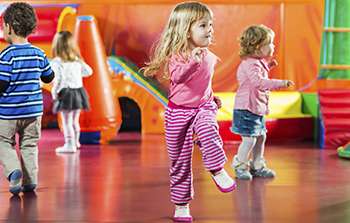Why Music and Dance
Young children love a blend of music, movement, rhythm and dance. This combination allows them to enjoy the music and express themselves.
Here are our top five reasons why music can be beneficial to the development of your child.
1. Music increases Children’s sensory development
Just as taste, textures and colours aid a child’s sensory development, so does music. Exposing your child to different types of music can help create more pathways between the cells in their brains. This effect increases even more when you link music to different activities such as dancing.

2.Music can improve literacy and numeracy
From an early age, babies can hear the difference between different types of sounds. After just a few weeks, a baby is able to identify their mother’s voice from other people’s. Exposure to music enhances a child’s natural ability to decode sounds and words.
By singing nursery rhymes to your child, you can help them to identify sound patterns and learn through repetition. In addition to that, music also helps children anticipate what is coming next in a poem or a song and they know how to put these patterns in a sequence. By mastering these skills, children build the base of literacy and numeracy.
3. Music is a mood lifter
A lot of parents tuck their children in with a lullaby or calm them down with a song. Just as music can soothe a child, it can also lift their spirit.
4. Music helps children build coordination
Even if your child doesn’t understand the lyrics of a song yet, they can definitely move to the rhythm of the music. You may have already noticed your child dancing to certain songs or liking certain pieces of music more than others.
Music encourages children’s inclination to move, developing their fine motor skills and gross motor skills. Plus, if the rhythm is very entertaining, you may even notice your toddler starting to jump up and down, which helps with their muscle development, strength and balance.
5. Music can help children develop their vocabulary
Even though at first your child may not understand the words in a song or in a nursery rhyme, they do develop their understanding by identifying the storytelling in a song. Take as an example the ABC song, where many children think that the sequence “l-m-n-o-p” is a word, “elemenopee”. As they grow, they will start to realise that it’s not a word, but a sequence of sounds, each sound being a separate entity.
[expand title = “ReadMore…” swaptitle=” “]
MUSIC
Introducing music in young children’s life develops concentration, memory and listening skills.
Singing songs helps children in learning speech patterns.
Singing songs develops a child’s vocabulary and if you incorporate dance into it, the child is able to recall the words through the movements.
Music stimulates new neural pathways and connections in the brain that speed-up the learning process.
It enhances the creativity and curiosity in children
RHYTHM
To be able to identify a beat within music helps develop the listening and concentration skills in young children.
To be able to move along the beat helps develop the motor skills in young children.
Research has shown that young children that are able to identify a particular beat do considerably well in academics.
If a child is able to recognize a beat and then replicate it, it means that he can easily identify patterns. This is a key mathematical skill.
MOVEMENT
Music allows the children to move a lot and hence form a strong relationship between the body and brain.
Movement stimulates brain development in young children. It encourages the formation of neural connections across the two hemispheres. So what better way to incorporate movement than through music?
Movement plays an important role in language development as early communication is entirely physical, and depends upon gestures and expressions. Music helps in speeding up the entire process substantially.
DANCE
Swaying along with the music helps develops children’s coordination, balance and control.
Research shows that movement across the body helps in developing neural pathways that assist in learning process. Hence, if the dance moves are designed in such a manner that they maximize this effect, it may help considerably in the child’s development.
Music and dance also help imbibe listening skills into the child’s personality.
Dance allows children to express themselves. This is a particularly important aspect especially when the child does not have the proper vocabulary to express himself.
As the various benefits suggest, Music, Movement, Rhythm and Dance are key aspects of development of a child’s personality. What a child learns at young age stays with him throughout his life. This is something that we should understand as parents and contribute our bit by incorporating music and movement in our child’s life.
[/expand]
